!!! My website has
moved: please update your bookmarks to debunix.net !!!
Daphnia
I keep a few going in a set of open trays on a
windowsill--in shallow water, figuring that without filtration or
aeration, my carrying capacity is limited by surface area. I
used to just toss them a pinch of dried brewers' yeast or a bit
of baby food sweet potatoes every few days, and change their water
with aged tank water when I do tank water changes. I did not get
many daphnia out of this--just a few dozen here and there as a treat
for favorite fish. But it kept them going until I saw the
light: during Joe
Fleckenstein's talk on live foods at the 2005 MASI show, he said he
used a little bit of everything he'd heard people used to feed them,
including, most intriguingly to me,
paprika. So I went out and got several things he mentioned--soy
flour, spirulina powder, and yeast from the health food store, a big
jar of paprika from the international grocery, and (my own inspiration,
no blame to Joe) some freeze-dried
peas, also from the health food store. I put all that you see
here together--thats 180g or about 6 oz of spirulina powder, 1 pound of
paprika, a 3.5 ounce container of the peas, about 4 ounces of soy
powder and about 4 ounces of brewer's yeast. Again, the
proportions were simply what I bought of each one, and not specifically
Joe's recipe. I bought a big jar of paprika, so there is a lot of
pepper in my version.
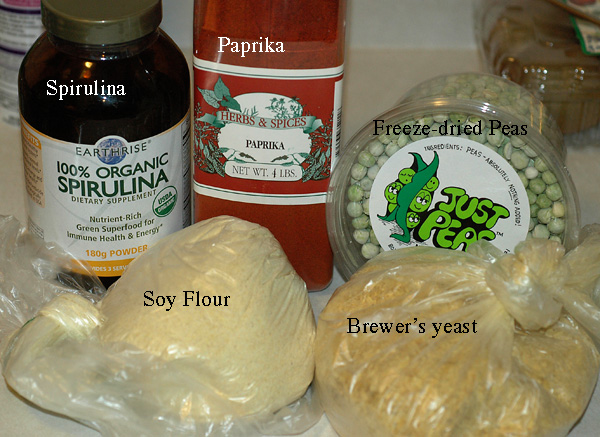
I whirled these together in the food processor (with a towel wrapped
around it to keep from pepper-spraying myself) until the peas were
powdered and all well-mixed. I put it in a spice jar and sprinkle
a bit on the daphnia daily. I have seen an incredible increase in
daphnia yield under this new regimen--so many that I suspect one of my
trays actually crashed from overpopulation because I wasn't harvesting
them fast enough.
Here are happy daphnia in their trays on the windowsill:
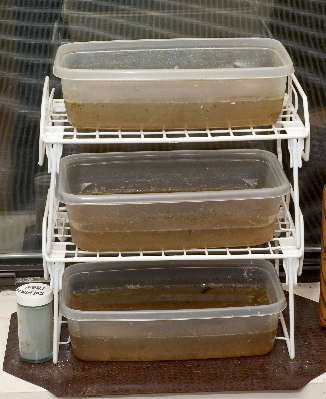
I keep them on the windowsill because it's a handy surface; they have
also done ok in a closed closet for a time. Light is not
necessary. The culture gets mucky on the bottom, but that's ok as
long as it doesn't get stinky.
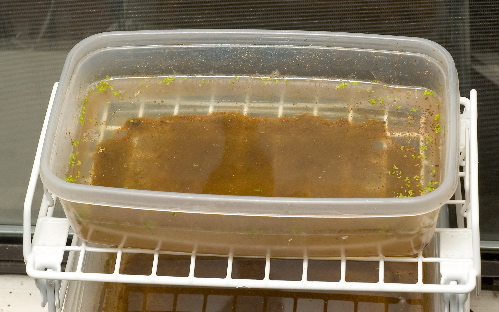
I use a baster to harvest them. You can see how they cluster in
the corners of the tray above. I put the baster there to avoid
the mulm from the bottom of the tray:

And I replace the liquid I remove with water from the tanks, because
they're supposed to prefer to live in aged tank water. I never
give them freshly dechlorinated tap water, only water from my
tanks. They seem to flourish a little more in the water from my
"hard water tanks" which is St. Louis tap water supplemented with a bit
of SeaChem LiveBearer Salt. I top them up at least once a week
with tank water, and
when the culture starts to stink, once every few weeks to a month, I
drain the entire culture into a brine shrimp
net,
along with whatever goop is on the bottom of the box, and rinse it back
into the box with tank water--in effect, doing a 100% water change, but
with aged tank water. I think I have daphnia pulex, which are all
caught by the net, but Moina macrocopa (often incorrectly called
Daphnia moina) are preferred by many fishkeepers
because the newly hatched babies are smaller than baby brine
shrimp--great for small fry--but require different feeding techniques
because they will slip through a standard commercial brine shrimp
net.
 .
.
The fish are quite pleased by every feeding of daphnia.
Although in theory they could survive in the tanks for days, they
never last very long before the fish chase down every last one of them.
One neat idea for making the best use of daphnia comes from Jack
Heller, who calls them excellent "babysitters" for young fry. If
you have to be out of town for a few days, putting some daphnia in the
fry tanks helps keep the water cleaner, as the daphnia filter feed on
some of the tank waste, and they also will produce babies that the fry
can eat (assuming the fry are too small to eat the adult
daphnia). Add a couple of ramshorn snails and your babysitting
crew is complete--they will help produce infusoria from the fish waste
that the daphnia will eat.
Daphnia vs Moina
Adult Moina, a similar animal from a different genus than Daphnia, are
the size of juvenile Daphnia, and juvenile Moina are smaller than newly
hatched brine shrimp. I recently got another starter culture of
Moina because the very small juveniles should be excellent for fry.
They're so small that they don't have enough density of pigment
in their bodies to appear orange to the naked eye, as the Daphnia do,
and they're about the same size as the cyclops that sometimes
contaminate and can take over neglected Daphnia cultures. But
though the both critters pretty much look just like white dots to my
eyes, Moina swim like Daphnia--jerky short
almost random-walk movements--and the cyclops are supposed to swim in a
smoother steadier motion. A closer look at the cultures (the
best resolution I can get until I find my macro extension ring for the
camera) reveals that the Moina do look just like juvenile Daphnia, and
up close, they have an orange cast just like the Daphnia.
Here are the cultures shot side by side (identical scale: the adult Daphnia are about 2mm long).
The arrowheads point to Moina in the right image--hard to see, of course, but easier to make out if you view the image larger here, and to a similar appearing juvenile Daphnia on the left image.

Here they are in more detail, at the same scale for both the larger images and the inset closeups:
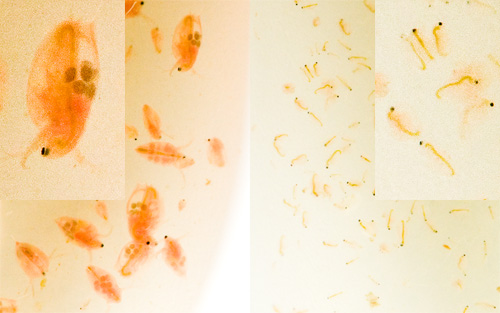
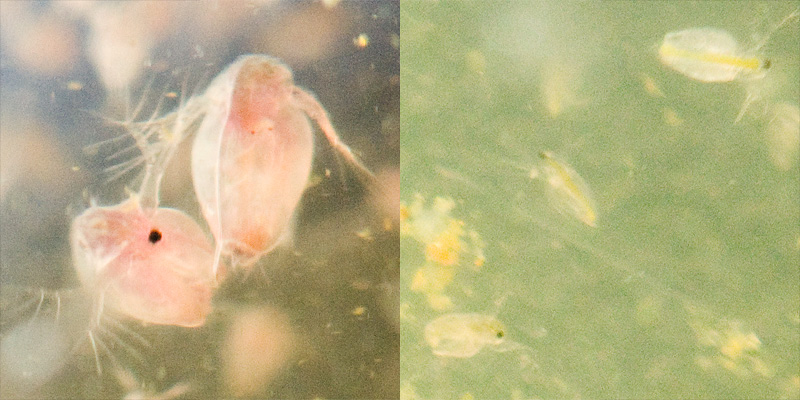

Return to Live Food Cultures Overview
Return to My Fishroom
Back to Fish Page
Return to Diane's Home Page




 .
. 


